Where to go in Switzerland on a short trip: Alps, lakes, and cities
Switzerland is an extremely popular country for those planning multi-stop tours around Europe, yet very few potential first-time visitors actually know specifically where they want to go. Everyone seems to know that it has the most beautiful views of the Alps and some very impressive cities, but there are actually many misconceptions among casual trip planners, so I’d like to clear most of that up below. The places to visit in Switzerland are not obvious until you’ve been there yourself or done many hours of research, so the list below should be a short cut.
I get hundreds if not thousands of itinerary questions for people who are considering a Eurail trip around Europe, and most people just include the word “Switzerland” among a list of cities like Paris, Rome, and Berlin that they want to visit. So where in Switzerland should you go if you can only make a few stops at most? I’ll answer that question below.
Note: This article was expanded and updated in February, 2024.
Switzerland is about outdoor views rather than city visits
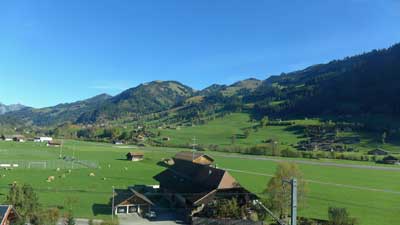
Geneva is a very famous city (though not for tourism reasons) on a lovely lake of the same name, but it’s also notoriously dull and lacking distinction. Rick Steves puts it well by saying that “Geneva is pleasantly situated on a lake, like Buffalo or Cleveland.” The point is, you don’t want to go to Geneva unless you’ve got something specific in mind that you want to see there.
Switzerland's cities in summary
Zurich – The largest city, very expensive, geared towards business travelers. It’s generally a pretty and very well-run city that you would enjoy if you visited, but it’s not nearly as interesting as the likes of Vienna, Munich, or of course Paris.
Geneva – Second largest city, in the French part of the country, no major sights. Again, if you visited you’d be very impressed by it and get some great photos, but it’s not worth your time unless you know someone there. There’s an impressive fountain in the lake and you can usually see it from the train as you go through the city, but it’s not really worth going there and staying more than an hour or so.
Basel – Bordering France and Germany, no major sights. It has the famous art market each year, and aside from that it’s even duller than the ones above. Again, if you visited you’d be impressed, but if you later compared photos with friends who went to the Lauterbrunnen Valley instead, you’d kick yourself for going to Basel.
Lausanne – Near Geneva in the French part of the country, very hilly, and certainly more interesting than Geneva.
Bern – The capital, compact, on a lovely river, some interesting sights and the best Swiss city to get a feel for the culture. Bern is fairly close to Interlaken (which we will discuss below) and it can be a great day trip from there, especially on a day where it is foggy and/or rainy in the mountains (and this happens a LOT).
How much time and which Swiss cities to visit?
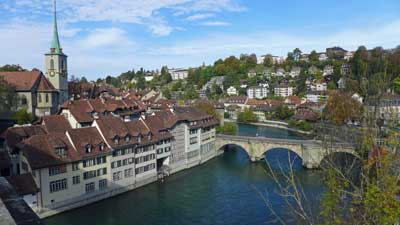
Many people (me included) don’t feel as if they’ve scratched the surface of a new country if they haven’t spent at least a day or two in the largest city. Zurich is certainly pleasant and a useful transit hub so spending one or two nights there wouldn’t be a major mistake. But Zurich isn’t even close to being a city like Paris, Rome, Berlin, Amsterdam, or even Vienna. If you skip it in favor of spending more time in the outdoors, you won’t be missing much.
The 2 Swiss places to focus on for short visits
Interlaken – If you want the best possible Alpine views and activities, head to the Interlaken area, which will be described in detail below.
Lucerne – The traditional Swiss tourist retreat, Lucerne is a small city with interesting culture and sights, that is gorgeously set on a lake with plenty of top activities surrounding it.
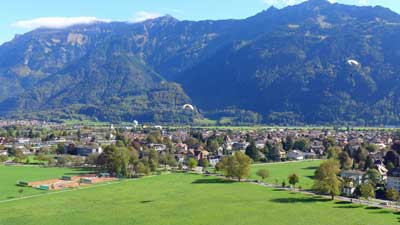
>>>Interlaken and Lucerne: Which to choose and how long to stay in each?
The article linked above will give you more details on which to choose and how long to spend in each place.
What about Zermatt for Alpine views?
Zermatt is a remote car-free village in southern Switzerland that is famous for being the place to see the Matterhorn mountain. It’s also a busy ski resort area, and aside from that, there isn’t much to see or do here. It’s on a private rail line, so it’s more complicated and usually more expensive to reach than Interlaken.
In other words, unless you’ve irrationally placed “Seeing the Matterhorn in person” on your so-called bucket list, skip Zermatt and head to Interlaken on a shorter visit. You won’t be sorry. If you already have enough time in your visit for the main sights around Interlaken and Lucerne and you want to also see the Matterhorn, then by all means go and you’ll enjoy it. There are quite a few other car-free villages in the Lauterbrunnen Valley near Interlaken, so they are not as novel in Switzerland as one might expect.
A weekend in Switzerland?
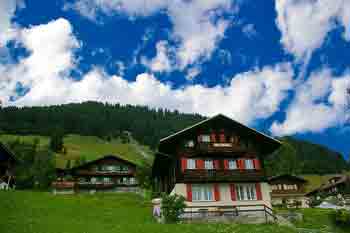
One challenge is that neither has an international airport so you’ll either be flying into Zurich or perhaps Geneva.
Train times from Zurich to Lucerne to Interlaken and back
- Zurich Airport to Lucerne: 1 hour 10 minutes by train
- Lucerne to Interlaken: 2 hours by train
- Interlaken to Zurich Airport: 2 hours 15 minutes by train
As you can see with the travel times above, Zurich Airport to Lucerne is a fairly short trip, but once you add Interlaken into the mix (even if you skip Lucerne) the travel time starts to add up for a weekend visit. With this in mind it’s probably best to just choose one of them and save the other one for another trip.
Lucerne is gorgeous, but the Lauterbrunnen Valley near Interlaken is really the star of the show, so I’d recommend going there first and doing Lucerne on another trip.
What about the Swiss Travel Pass?
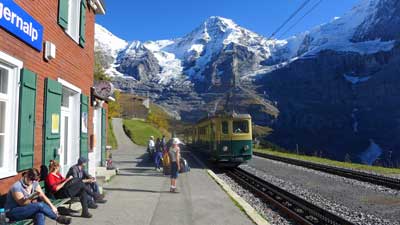
The bottom line is that if you are coming to Switzerland for at least 3 days and you want to take 2 or more of the amazing scenic rail journeys that the country is famous for, the travel pass is probably a good deal. It also provides 50% discounts on the Schilthorn cable car and 25% off the Jungfraujoch mountain railway. Both of those are quite expensive on their own, but extremely worthwhile, so the discount is helpful.
The Half Fare Card is probably a better deal for most people
The Swiss Travel Pass is a good deal for those who are going to be spending at least 2 or 3 days riding the rails and seeing Switzerland that way. But if you are mostly going to be focusing on Interlaken and Lucerne and the mountain sights, the Half Fare Card is the best option. For CHF120 (about US$134) you get the card that is good for 30 days and gives you a 50% discount on all trains, cable cars, mountain railways, and other sights and attractions. If you are doing either Schilthorn or Jungfraujoch, the Half Fare Card practically pays for itself with just one of those.
>>>Buy the Swiss Half Fare Card
Many people have questions about the Swiss Half Fare Card so I will explain it a bit here. You can actually buy half price train tickets for travel within Switzerland any time you want and you will see that option when you go to buy them online. The only thing is you have to have and present a valid Half Fare Card when you get on the train and are asked to see your ticket. In other words, you can buy a half fare train ticket today and buy a Half Fare Card just before you get on that train months in the future, and you are fine.
How and why visit the area around Interlaken
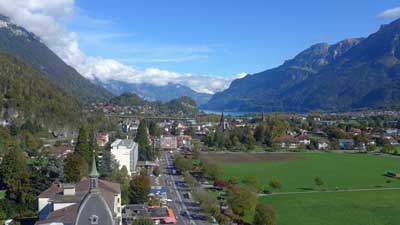
You can see everything discussed below by actually staying in a hotel in Interlaken, but it’s not the Alpine experience that you get if you stay in one of the small villages nearby. You can reach those villages in 20 to 40 minutes from the Interlaken Ost (East) train station, and it’s much easier than it sounds.
The 3 best places to stay to visit the Swiss Alps
Lauterbrunnen – A private train line runs from Interlaken Ost station to the end of its line in Lauterbrunnen. There’s a lovely waterfall here and great hiking trails, but you should probably only stay here if you can’t get to one of the villages mentioned just below. It’s a great little transit hub and it’s definitely gorgeous, so it can be worth a night if you’ve got one to spare.
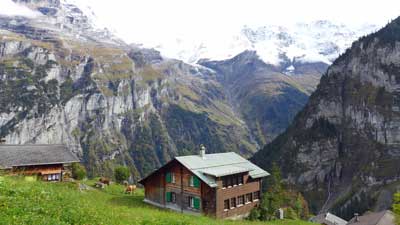
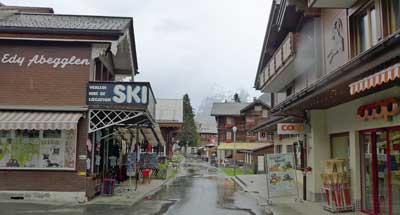
Where to stay in Interlaken and the Lauterbrunnen Valley (with pics)
I get so many questions about where to stay in the Interlaken area that I decided to write a longer version of it and load it with huge photos so readers can get a better feel for each option. I also included recommendations for affordable and well-located photos in each area.
>>>Where to stay in Interlaken and the Lauterbrunnen Valley New for 2024!
The unforgettable things to see here (if the weather is decent)
Schilthorn observation deck and restaurant
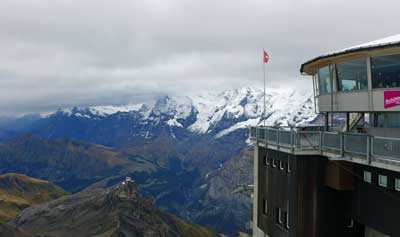
There is a rotating restaurant (with prices similar to normal Swiss restaurants) and a bizarre and anachronistic James Bond attraction based on it being a key location in the 1969 movie On Her Majesty’s Secret Service. The Bond thing is included with the lift, and it’s worth a look.
But the main thing you come here for is the 360-degree view from one of the highest peaks in Europe. Again, the weather here is key, but fortunately all the locals track the visibility on a minute-by-minute basis. If it’s clear up top while you are in the area, it would be a terrible shame to skip it based on the high price. But even if it’s cloudy up top, there are still plenty of wonderful things to see and do in the villages below.
Jungfraujoch observation area
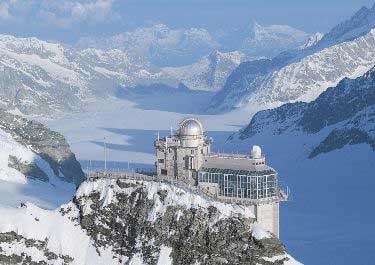
The views from the top are similar to the views from Schilthorn, from the other side of the Lauterbrunnen Valley. Once on top you can have lunch, hike, or even go sledding. It’s also quite expensive at nearly US$200 round-trip unless you have a Swiss Pass or a Eurail Pass for discounts, and it takes most of your day, but you’ll never forget the views from the top.
Harder Kulm mountain and Two Lakes Bridge Observation Deck
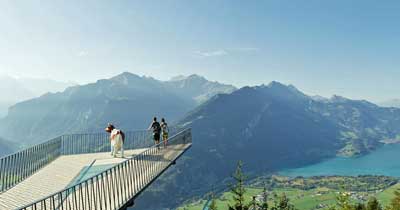
There’s a revolving restaurant about 10 minutes’ walk from the station at the top, which is definitely an unforgettable place for lunch if you’ve got time. It’s not as expensive as you might expect, at least compared to normal restaurants in Switzerland.
The Harder Kulm Railway goes from early April through late November each year. If you are only in Interlaken for one day and/or you are on a strict budget, this is the fastest and best way to get amazing Alpine views in the area.
Getting from Interlaken to Gimmelwald and Mürren
Getting up to these villages sounds complicated and time consuming, but it’s actually fast and easy once you get there. This little guide should help.
Arrive in Interlaken
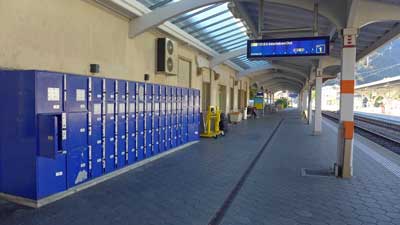
Once you arrive at the Interlaken Ost train station, head for the ticket windows in the office and buy a ticket to your final destination (Lauterbrunnen, Gimmelwald, or Mürren). Eurail passes are good for 25% discounts on the rest of the trip, but not for the whole thing.
From Interlaken Ost to Lauterbrunnen
The private train leaves Interlaken Ost every 30 minutes and arrives in Lauterbrunnen 20 minutes later. If you are staying in Lauterbrunnen then you are probably walking distance from your hotel when you reach the station.
From Lauterbrunnen to Gimmelwald
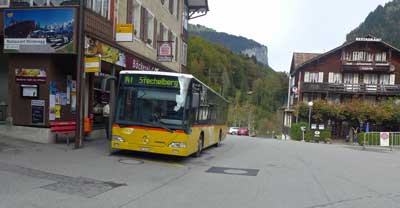
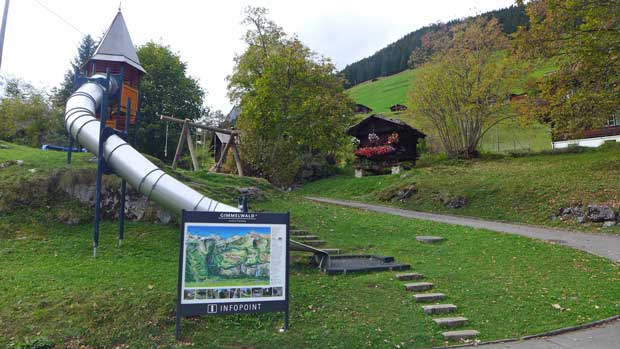
From
Gimmelwald to Mürren
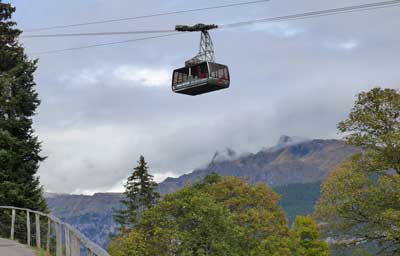
Recommended hotel and hostel in Gimmelwald
I get asked all the time about where to stay in Gimmelwald, so here it is:
Hotel: Esther’s Guesthouse
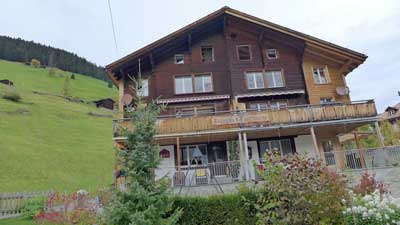
It’s run by Esther, as you might guess, and she is very friendly speaking excellent English. Each room is different and the place feels like a mountain cabin, because it is. She offers an excellent buffet breakfast in the morning, which you have to order the night before. It’s not cheap, but it’s worth it because it’s hearty and there are no other good options nearby.
Book as early as possible because this place is often the first place to sell out in Gimmelwald.
Hostel: Mountain Hostel Gimmelwald
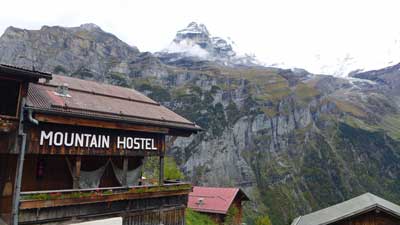
You won’t believe the views from this place, which are the same as from Esther’s except a bit lower and more unobstructed. This place also has a busy bar and restaurant that is basically the only “nightlife” in Gimmelwald. Many hikers get to bed early in this tiny village, but if you want to have a couple drinks and order a pizza or some local options, this is the place to go.
Again, book early because this place is always sold out.
Lucerne and what to do there
Luzern, as it’s spelled locally, is the other traditional holiday destination in Switzerland. Unlike Interlaken, Lucerne actually qualifies as a small city rather than a small resort town, so it’s a very nice contrast and very worthwhile.
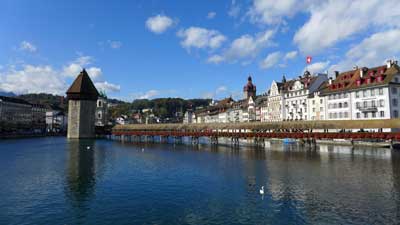
However, unlike Interlaken, the town of Lucerne itself is a great attraction and worth at least a day of exploration. This has always been a rich area so you can expect to find all of the high-end shops and boutiques along the small streets just north of the lake, but there are also many traditional shops and things to see that will appeal to anyone.
Recommended hotel in Lucerne
>>Hotel Des Alpes (3 stars with an amazing location and view)
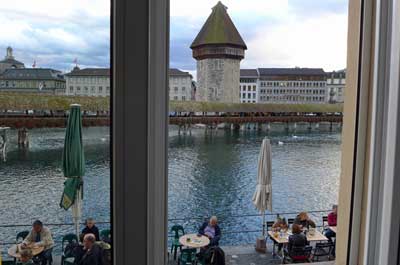
If this place is booked, which is often the case, then book a hotel as close to it as you can find or afford. The whole historic part of town surrounding it is lovely, with restaurants, bars, and high-end shops. There are also a couple of nearby supermarkets where you can buy inexpensive alcohol and picnic supplies to keep other costs down.
Spend a day in Lucerne itself
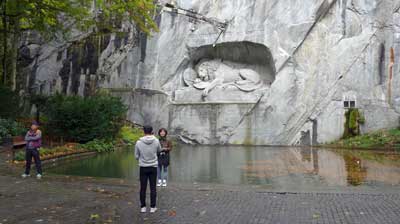
Most of the interesting part of Lucerne is in the area behind those restaurants, and it’s certainly worth doing a self-guided walking tour if not a guided one. Heading farther east you’ll come to another older part of town where the famous lion statue is located. You can’t visit Lucerne without having a look at the lion, and fortunately it’s easy and quick to reach (and it’s free).
Take a lake cruise of some kind
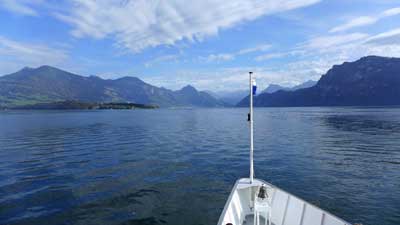
Especially in nice weather, even the short lake tour is lovely, and if you have more time you can jump off at Vitznau and do the scenic hike up Mount Rigi. There are also small lakeside villages that are ideal for a stroll and lunch stop. Long story short, there are dozens of interesting sightseeing options that are available using part of the boat tour, and the views all around are wonderful.
Visit Mount Pilatus
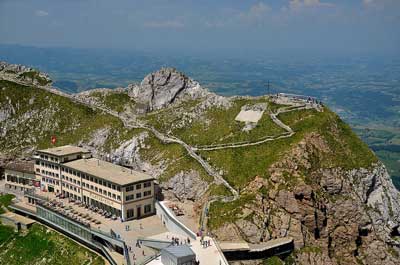
You can take the cogwheel train up and have a more or less flat hike around the summit area, and then take the gondola and cable car back down again. You can do them in the other order, and the cost is the same either way. At around US$65, this is not a cheap hike, but like most everything in Switzerland, the quality is high so it doesn’t feel like a rip-off. You can reach the cable car in 10 minutes on a public trolly bus from Lucerne.
Visit Mount Rigi
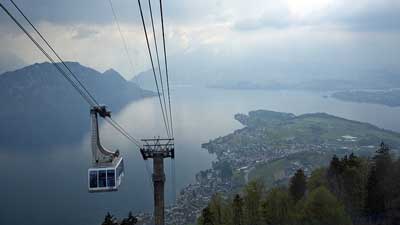
Unlike the other peaks mentioned in this article the Swiss Travel Pass covers both ways to get up and down for free. The others are 50% off with the Swiss Travel Pass or Half Fare Card, except for Jungfraujoch, which is only 25% off with the Swiss Travel Pass and still 50% off with the Half Fare Card.
Visit Mount Titlis
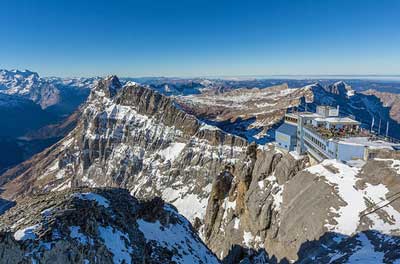
You can reach Titlis by taking a 43-minute train ride from Lucerne to Engelburg and then taking the cable car up from there. As with the others, it’s wise to check the weather immediately before you are going to depart because it can be foggy or cloudy any time of the year, but usually not for whole days at a time.
Additional photo credits
Jungfraujoch by cupweuro on Flickr, Pilatus by Tony Fernandez on Flickr, Rigi by Kosala Bandara on Flickr, Titlis by PaulSchliebs on Flickr

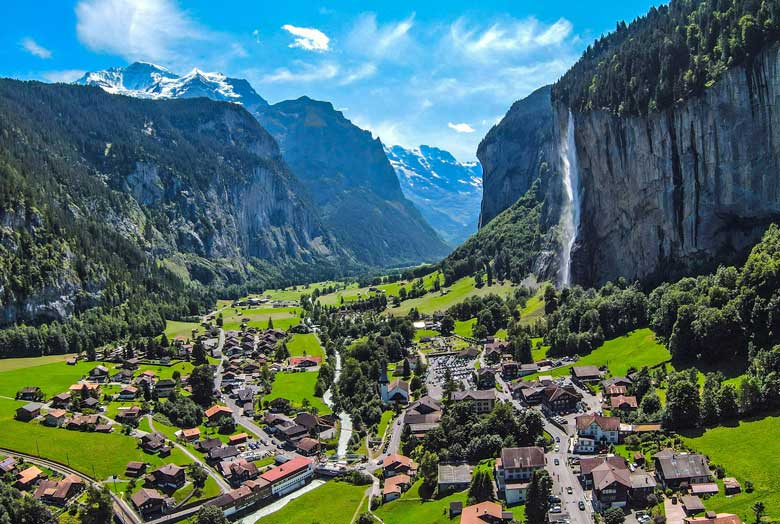
Where did you suggest is best to visit Switzerland for a short trip out of Italy? We are going into Venice and out ofmilan for a 14 day trip but we really would like to Switzerland while there! We are staying in lake como for a few days in between. Thank you!! My hunt really wants to see the alps!!
Lauri,
From the Milan area, the entry point into Switzerland is the mountain town of Lugano. You can get there by train from Como town (at the south end of Lake Como, or by bus from the western shores near the middle of the lake. Lugano is a larger town but otherwise not much different from the small towns on Como, so it’s probably worth pushing on into Switzerland from there. You can get to Lucerne by train in about 2.5 hours from Lugano, or to Interlaken in a bit over 4 hours. In fact, the train from Lugano to Interlaken is one of Switzerland’s named “scenic” train routes, known as the Wilhelm Tell Express.
So it really depends on how much time in Switzerland you have. If you have only one night you might want to take the train to Lucerne and back, or if you have two nights you might go all the way to Interlaken, which has the best Alps views and activities. As always, let me know if you have any other questions. -Roger
Hi,
I am planning a 3/4 days trip to Switzerland with my wife and one year old Son. I am not sure where to start and end the trip, should I take a flight to Zurich or Geneva and then start the trip ?
We are interested to see scenic view, alps. Could you help me in preparing the itinerary keeping in mind that I am travelling with my One year old son. I am planning this trip in July.
Jags,
Zurich is closer to both Interlaken and Lucerne, and it’s a larger airport that usually has lower fares, so that’s where you want to fly into. The airport itself is on the main train line, so you can take a train directly from the airport to Interlaken, and skip going into Zurich.
The whole article above describes where to see the best views, but the short version is that you should spend at least 2 or 3 days in the Interlaken area. If you have one more day you might also go to Lucerne for that day, as it’s also lovely, quite different, and easy to appreciate in about 24 hours.
My advice to everyone is to plan on spending at least one or two nights in the amazing little village of Gimmelwald, or in the larger resort town of Murren (one stop up on the cable car from Gimmelwald) if Gimmelwald’s hotels are sold out, or if you require a wide variety of restaurant choices.
For anyone who has time, I recommend spending one night in or very near the town of Interlaken itself. It’s the hub for pretty much all nearly Alpine sightseeing trips, and the town itself is really nice. With that in mind, have another look at the article above for more specific instructions, and let me know if you have any more questions. -Roger
Thanks Roger !
I have got 8-9 days now for visit to Switzerland. Could you please help me in finalizing my itinerary? I am not sure, how many days I should spent to see below places. You can also add or remove any city from the below:
Interlaken
Lauterbrunnen
Gimmelwald
Mürren
Jungfraujoch
Lucerne / Luzern
Regards,
jags
Roger,
Awesome review. Thank you so much for your time!
Need your advice about an upcoming trip we have planned this Jun-Jul 2017 as to whether it’s “do-able” logistically based on your experience. We will be traveling by train between Paris and Rome in late June. We’d like to stop to see Schilthorn or Jungfrau on the way with a stop in Milan before heading to Rome. Budget is not an issue for us. There will be 2 couples and one single traveling. We would like to leave Paris by train on Wed, Jun 28 and stay either in Interlaken or Gimmelwald or Murren (based on your recs above) for one night. Wake up the next day (Jun 29) and travel to Schilthorn, have a meal at the restaurant, etc, then return in the afternoon to catch a train to Milan. We’d like to stay one night in Milan on the 29th, see some of Milan the next day (30th) before traveling by train to Rome where we’ll spend 4 nights. Is this itinerary too ambitious? Or should be stay in the Interlaken area for 2 nights and skip Milan and head straight to Rome? Thoughts? Thank you.
Jay
Jay,
I’m always happy to hear kind words like this. Your plan would work pretty well to do just one night in Switzerland, although two nights might be the better option. As long as you leave Paris early enough you can easily make it to Interlaken or Gimmelwald or Murren. Those cable cars run every hour and go until 10pm or so, as they are used as local transport, but still I’d recommend trying to get there before 7pm so you can appreciate it during the light. It probably gets dark around 9pm there in late June, so even the 8pm cable car could work.
Other times of the year you sometimes have to worry about fog or haze near the top, but in late June you’d be very unlucky to get foul weather, although it can happen. The train ride from Interlaken to Milan is really spectacular as well. So those would very a couple of very memorable days where you’d be seeing some of the most amazing views in the world. That said, spending another day there would be wonderful, especially if budget isn’t an issue.
Milan has an interesting area near the cathedral, and if you apply early enough you might be able to get into see the Last Supper. But aside from that, it’s kind of a dud for tourists compared to Venice, Florence, and Rome. Have a great trip and let me know if you have any other questions. -Roger
We are planning a trip to Switzerland in September. We have traveled to Ireland and France and rented a car those trips. We are trying to figure out if it is better to travel by train or if we could do it by car. We like to keep a flexible itinerary and see the sights as we like. There are 2 couples traveling together, we have a week to see the sights. Thank you for your help! Our travel agent would not give us her advice on this.
Angie,
I almost always advise against touring Europe in a rented car, but Ireland is one famous exception, and France is as well as long as you want to spend time outside of Paris and the other larger cities. Particularly for seeing wine regions and battle memorials and that sort of thing, a car is ideal.
Switzerland could be another good place to visit by car as long as you don’t want to spend much time in cities, and that’s probably a good idea anyway. So especially for two couples, as driving will be much cheaper than 4 train tickets, I think it’s a fine idea.
The town of Interlaken has a suburban feel where many hotels and other businesses have free parking lots. The tourism hub of Lauterbrunnen is even more spread out, so parking will be easy. I’d still recommend staying in Gimmelwald or Murren for a night or two if you can, and those are car-free villages, but you should still find an easy and reasonably priced parking spot near the cable car station below. You’ll also be able to drive to most of the other mountain villages, where you can park free or cheap and then go hiking or take a cable car.
Lucerne is a larger city and has quite a dense center, so parking near the lake won’t be free, but at least it shouldn’t be difficult.
And if you wanted to visit a city it should probably be Bern, and that would be similar to Lucerne in that you’d have to pay to park, but it shouldn’t cost a fortune.
So again to be clear, I think for 1 or 2 people the best way to get around Switzerland is usually by train, or even for larger groups that just want to go to the main destinations and don’t want to go to the trouble of renting a car and sorting out parking. But for a group of 4 who has a week and wants to move around quite a bit, I think a car is the way to go. Have a great trip. -Roger
Hi Roge,
I am planning to visit Interlaken and Lucerne for 3 days from 24jun to 26jun. Currently I am in Turin (italy)on some company work. I am facing some difficulties in planning and tickets.
1. Is better to directly go from Turin to Lucerne and while returning going for Interlaken?
2. Which place is better to spend more days among Interlaken and Lucerne?
3. Could you please suggest me to go around in 3 days?
4. Is it useful to take Swiss pass for travelling in Lucerne and interlaken? If so, at which places it is useful like transport, museum, skiing etc. And which pass is better?
5. If the Swiss pass is taken, can I use it for Turin to Lucerne transport or only useful after entering Switzerland?
Thanks & Regards,
Reddy
Knagarjuna,
It appears to be easier to go to Lucerne first, because there are more departures in the mornings. It will take about 6 hours, although you can get to Interlaken in around 5 hours if there is a connection when you want to go. It takes about 2 hours to get between the two cities. What I’d do is go to the Swiss rail website and check your itineraries. Since Turin is a bit out of the way, there aren’t departures every hour like there are out of Milan. As long as you plan ahead, you can definitely put together a convenient itinerary though.
If I only had 3 days I’d spend one day in Lucerne and two in Interlaken. Both cities are wonderful, but Interlaken has the dramatic Alps views that we all love.
So yes, leave as early as possible to get to Lucerne in the early afternoon. Spend the day and next morning there, and then take the train to Interlaken for your other two days. As mentioned in the article above, if you can stay in Gimmelwald you should.
The Swiss Passes look expensive to me and I think you have to be taking a lot of train rides and visiting many museums to get value out of them. They are only valid for travel and attractions within Switzerland, so your journey before you hit the border would not be discounted. Have a great trip. -Roger
Hi Roger,
Thanks for your prompt reply.Is it possible to cover Mt.Titlis also besides Lucerne and Interlaken in the same 3 days. If Yes,then what are all the costs involved from Engelberg to top of the mountain and activities on top of the mountain. Thanks in advance.
Knagarjuna,
Yes, technically you could visit Mt Titlis within those 3 days, but I’m not sure I’d recommend it. Titlis isn’t very close to either Lucerne or Interlaken, so the trip along with the time to go up the cable cars to the summit area will take most of a whole day. It’s one of Switzerland’s best views so it’s worth considering. However, if you were going to spend one day in Lucerne and two days in Interlaken, you’ll find many other worthwhile sights and attractions that are much easier to reach, so you can do 2 or 3 things each day. For example, if you are staying in Gimmelwald or Murren, you are already part of the way up Schilthorn, so visiting that observation deck can be done in only 2 or 3 total hours.
As for the prices, there are many different cable car rides available. The one all the way up to the top costs CHF89 (around US$90) return. All of these mountaintop cable car rides are in the same price range, but once you are up at the top you’ll see why it’s worth it. -Roger
Hi Roger,
Thank you very much for your reply.
Thanks,
Reddy
Hi Roger,
Good day to you. I’m planning to visit Switzerland by middle of June with my husband and two boys. First I would like to know how the weather like around these time? I would like to have a panoramic view of lake and mountain besides beautiful view of flowers. Is there any chocolate factory around those places as well? Would you suggest which place we should visit? By the way we might be staying for 6 days. Could you recommend some quality hotel around those places and which train pass we should buy? Thanking you in advance.
Vani,
The June weather in Switzerland will be warm, sunny, and beautiful in the valleys and flat-lands, and chilly and a bit unpredictable the farther up the mountains you go, but there won’t be snow falling except for the highest peaks.
The best panoramic views of lakes and mountains are from near Interlaken or Lucerne, as described above.
There are about 15 chocolate factories in Switzerland, though none of them are near Interlaken. However, there is one in Lucerne, as well as something called the Swiss Chocolate Adventure attached to the popular transport museum there.
If you have 6 days I’d spend at least 2 or 3 in the Interlaken area and at least 2 or 3 in the Lucerne area. You’d still have time for one day visiting Bern if you want to see the most beautiful Swiss city, or you could stay longer in Interlaken. And as mentioned in the article above, you should try to spend at least a night or two in Gimmelwald or Murren, which are just above Interlaken.
I get so many questions about hotels in Switzerland that I will write an article soon with my favorite ones and best advice. But for now, the only one I can recommend without any more research is Esther’s Guesthouse in Gimmelwald. It does get booked well in advance, however.
The train fares in Switzerland are pretty reasonable because the distances are short and the prices are the same no matter when you buy. So buy tickets once you get there and they will be cheaper and more flexible than a rail pass. Have a great trip. -Roger
Hello Roger,
u are the Federer of tours and travels I must say. crisp and clear answers.i am planning to visit paris for 3 nights,nice for 2 nights, then want to go to Interlaken for 3 nights and then move further to venice for one night and rome for 2 nights.please tell me is it a good itinerary and also I want to know how I can travel between these cities starting from paris and ending in rome.i am with my wife and 2 kids below 10 years.
Roy,
That is nice of you to say. As for your itinerary, I can see why you’d plan it that way, but getting in and out of Nice is going to be challenging. There are just no fast trains running between Nice and Switzerland, so it would take at least 9.5 hours to get from Nice to Interlaken, and it would be very expensive. You’d have the same problem if you did it the other way around, with Switzerland in between Paris and Nice.
So as nice as Nice is, I’m going to recommend saving it for another trip. You don’t mention when you are going, but if it’s between June and September, Nice will be very crowded and hotels will be expensive because that’s where so many French people go for their one-month holiday. Besides, Italy has many more cities that are actually more interesting than Nice anyway.
So I’d recommend Paris to Interlaken to Venice. You can do one night in Venice because it’s a small place, but two nights in Rome will feel rushed because it’s huge and has so many worthwhile things. Also, most people stop in Florence for at least two days in between Venice and Rome.
If you are saving Nice for next time, you’d have two nights to work with. You could spend those in Florence and you’d love it, or you could spend one more in Rome and one more somewhere else. My recommended rushed trip to Italy is one night in Venice, two nights in Florence, and three nights in Rome. If you can do that, you will have an amazing time and you’ll see why three nights in Rome is critical if you can spare them.
And you’ll definitely want to travel by train. The kids will get cheap fares, and even the adult fares will be reasonable if you buy them online in advance from the official rail sites for the countries involved. As always, let me know if you have any other questions. -Roger
Roger, thanks a lot for your crystal clear answers,advice and suggestion. I guess, as you rightly said ,I might fall short of time if I go to the French riveira though I badly wanted to see the beaches and Cannes and soak in the atmosphere. I am planning to travel for 11 days starting 29 august.Now I guess 3 nights in paris,3 nights in Interlaken / Lucerne,1 night in venice,1 night in Florence,3 nights in rome might be best for me. Can u recommend some quality hotels for these places?Can be international chains like holiday inns or intercontinental. And also in these places are there beaches to go to?thks for your help.
Roy,
I’m happy to help. As for hotels, it’s hard to recommend specific places because rates go up and down and many of the best places get booked well in advance. Still, I’ve put together articles with recommended hotels in Paris and the Italian cites on your list, and you’ll find links to all of them near the bottom of this article:
https://www.priceoftravel.com/7332/europe-trip-planning-guide-itineraries-transport-accommodation/
Even if the specific recommended hotel isn’t available or is showing a higher price, at least you’ll see the better neighborhoods to focus on so you can certainly find a good place nearby.
Unfortunately, there are no easily accessible beaches in or near those cities. There are some small beaches near Rome, but I’ve never heard anyone say that they are worthwhile for short-term tourists. The problem is that there are so few sandy beaches, or even pebble-covered beaches, in France and Italy, that the few decent ones that are there get completely packed all during the warm months. Spain, on the other hand, has plenty of great beaches. If you were spending longer in Italy you could potentially spend a day in the Cinque Terre region, and one of those towns does have a nice, sandy beach. But you will already be rushing, and otherwise that area doesn’t have enough to see to justify it. Let me know if you have any other questions. -Roger
thanks roger for your reply. I have a question related to port of entry. i am actually having 4 nights in france and 4 nights in Italy and 3 nights in swiss, so if I arrange schengen visa through italian embassy can I arrive in france for my first port of entry or will france refuse me saying that I must have applied in French embassy for the Schengen visa.
Roy,
That’s an interesting question and unfortunately I don’t have any information on it. I’m an American so I can enter the Schengen Zone with just my passport. I’d guess that any Schengen visa would be valid at any entry point, but that’s just my guess. I’m sure you can find an answer elsewhere. -Roger
Hi Roger
I have read your posts and found them very helpful, thanks for those.We are going for a 7 days training program in Sargans,Switzerland from 5th to 11th June.We would be in Grossfeld Sargans,please suggest which nearby places will be better to visit. We would be free in the evening time after 7 pm and also would have two full days to travel..
Also please guide better transport options..
How much time it would take to reach Interlaken and Lucerne from Sargans.Which are the better Alps view nearby Sargans?How would be the weather??
Uttam,
Ah, you’ll be very near the Lichtenstein border, which is an area I don’t know too well. You’ll be just a bit south of the small town of Appenzell, which is famous for its cheese and being a friendly small dairy town. It’s better to see it during the day, so you might not have time.
Lucerne is 1 hour and 48 minutes away from Sargans by train, and Interlaken is 2 hours and 54 minutes. The area you’ll be in is quite scenic, but for those two free days I think I’d head to Interlaken or at least to Lucerne, depending on which sounds better. The train rides to either one are gorgeous as well. It’s hard to be more specific than that. I’m sure when you get there you’ll get great advice from the locals. And since the domestic Swiss train tickets are always the same price, you can plan and buy at the last minute and it still won’t cost too much. Have a great trip. -Roger
Hello Roger,
Thank you very much for your reply and guidance..Uttam
Hello Roger,
we are travelling to switzerland for 5 days . We have chalked out an itinerary can anyone suggest if we should exclude or include anything .
Day 1 – Luzern – Lake, Chapel bridge , Local tour
Day 2- Mt. Titlis
Day 3-Interlaken , Lauternbrunnen, Grindelwald ,Jungfraujoch
Day 4 – Glacier Express/ Golden pass line
Day 5 -Geneva
Day6 – Zurich – Rhine fall
Can we skip geneva and include places like gimmelwald or bern or suggest any other places,
Garima,
I think your plan looks quite good and that you’ve got it filled with highlights already. Really, the only suggestions I’d make are the ones you mentioned at the end. Geneva is a famous city with almost nothing interesting to see or do there, while Bern (the capital) is gorgeous and the best Swiss city for a short visit.
And Grindelwald is a fairly large town with a gorgeous setting that is mostly known as a winter sports resort, while Gimmelwald (on the other side of the mountain) is a stunning and tiny village with an even better view, and an experience you won’t find anywhere else in the world. You could spend a week in the Interlaken area on different hikes and cable cars and view points and such, and you wouldn’t be bored. But on a quick visit, I think Gimmelwald is the most magical place to stay, or at least spend a couple hours in. The Schilthorn (above Gimmelwald and Murren) is the other don’t-miss attraction near Interlaken along with Jungfraujoch, although both are (justifiably) expensive so many people choose just one or the other.
Also, I’m not sure I’d want to do two scenic train rides on one day. In my experience, just about every train ride in Switzerland is extremely scenic, even if it doesn’t have a special name. And after about 3 or 4 hours of admiring the jaw-dropping scenery, it’s hard to continue to focus on it. So my general recommendation is to take trains to and from the things you want to see and visit in Switzerland, rather than focus primarily on the few train lines that have special names (and sometimes special carriages).
As always, let me know if you have any other questions. -Roger
Hello Roger,
Thank you so much for your thorough post on Switzerland and all the comments and your responses help a lot as well. I am planning a backpacking trip around Europe and would love to visit Switzerland. I keep hearing how expensive this country is so any tips/advice on making it accessible but still enjoyable for a budget backpacker would be helpful!
I am still in the beginning stages of planning but would love your insight. So my plan is that I will be coming from Milan/Lake Como, traveling to Interlaken by train, stay for 2 days, then train to Lucerne, stay for a night, and then to Zurich for 2-3 days with a possible day trip to St. Gallen. I know it seems long for Zurich but I have a few friends in Zurich and St. Gallen that I want to visit and will most likely stay with (which will help with costs). Do you think that is a great plan? How much are the trains usually for that type of route? And from reading all of your responses to other readers, those train routes should be quite scenic as well? How much could you see this entire trip to be roughly? Or should I skip Lucerne and go straight to Zurich from Interlaken?
Budget is a big concern so I don’t want to stick around areas that are overrated and I can just skip to save money.
Thank you so much for your help!
Helen,
As long as you have a place to stay in Zurich then I think visiting for several days will be lovely. The thing about Zurich is that it caters almost exclusively to business people and/or the rich, and not really to budget travelers. Basic hotel rooms in the center start close to US$200/night, and those same rooms would be around US$100/night in Paris, which has MUCH more to see. If you go to a sit-down restaurant, even a casual place, the cheapest meal on the menu will be CHF19 (US$20), without a drink. So it’s not so much that it’s boring or overrated or a bad place, it’s just terrible value compared to almost anywhere else in Europe, and there are very few (none, really) must-see attractions. But with a free place to stay and being able to eat some of your meals at home, it will be fun and worthwhile.
I think your plan sounds really fine and I’d definitely include Lucerne because it’s a wonderful small city that is nothing like Interlaken and that area. A standard 2nd Class train fare from Interlaken to Lucerne is CHF32 and it’s the same from Lucerne to Zurich, and the price is the same no matter when you buy them. That’s not exactly cheap, but especially for a last-minute ticket, it’s not bad at all, and the trains are very nice and famously punctual.
Pretty much every train ride in Switzerland is quite scenic, especially any of them that go along the Alps or through the Alps. The trains closer to Zurich aren’t quite as scenic, and there are a few long tunnels you go through, but still most of the country is green and hilly or mountainous.
As for general budget tips, book your hotel or hostel online in advance. Quality tends to be high, but still I’d recommend against getting a really remote place to save US$10 or US$20 per night because you’ll spend that much or more going back and forth, or at least you’ll waste a lot of time. Generally speaking, Switzerland is a splurge, but it’s worthwhile. I’m generally quite thrifty and my instinct is to always see just how cheap I can do things, but Switzerland is so nice that it’s worth just paying what things cost, and trying to save money in other countries.
After accommodation, the other tricky thing is food. Even a “meal deal” at McDonald’s in Switzerland will cost around US$14, and something like a doner kebab from a take-out place will be the same. As mentioned, sit-down meals start at around US$20 at every single restaurant. However, you can buy a prepared sandwich at a supermarket for around US$5, and groceries in general aren’t too expensive. Alcohol in supermarkets is actually quite cheap (1L of vodka for US$10). So if you stay in a hostel with a kitchen, even in a private room, you can save a lot by cooking some of your meals yourself, or buying prepared foods at supermarkets. There are large supermarkets (Coop is the most common one) in or very near every train station in the towns you’ll be visiting, by the way.
One sort of nice thing is that Switzerland isn’t really a foodie destination, so you won’t miss much if you avoid proper restaurants. You might want to try fondue once, but aside from that, it’s pretty much the same as German food except at 2 or 3 times the price.
The last tricky thing are the attractions. Most notably, the long cable car ride up to Schilthorn or the train ride up to Jungfraujoch. Both of those are shockingly expensive at first glance, but as long as the weather is decent, they will be the highlights of Switzerland and maybe your whole trip. There is just no substitute elsewhere for those experiences, so I’d budget for at least one of them.
As always, let me know if you have any other questions. -Roger
WOW! Thank you so much for the very thorough response. Definitely covered everything and more! I will peruse the rest of the website to help in planning the remaining parts of my Euro trip. I am sure it won’t be the last you will hear from me! Thanks again, Roger!!
I have read all the post and ask your advice. We are on a tour which spends two nights in Lucerne then buses you to Zurich for plane home. We have decided to stay an additional 4 days and thinking of all your recommendations I think we will leave Lucerne and head to Interlakenhoheweg for two nights then Murren for one then train to Zurich and spend a night there. Does this sound like a good plan?
Maggie,
You’ll definitely want to get between cities on trains rather than buses, although you will need to take one short bus ride on your way to the cable car leading up to Murren. I think your plan sounds really nice. Zurich is a fine city, but there really aren’t many things to see, and it’s extremely expensive. The Zurich Airport is on the main train line, so you could just as easily go directly there from Interlaken or Lucerne, and skip the night in Zurich if you wanted. The trains are fast, famously punctual, and they start at about 5am, so you can easily reach Zurich Airport from any of those cities in the morning.
And again, if you want to see one Swiss city, then Bern is probably the best choice as it’s more photogenic and has more things to see than the others. So with all of this in mind, you can spend those days in several different ways and be good on timing. Let me know if you have any other questions. -Roger